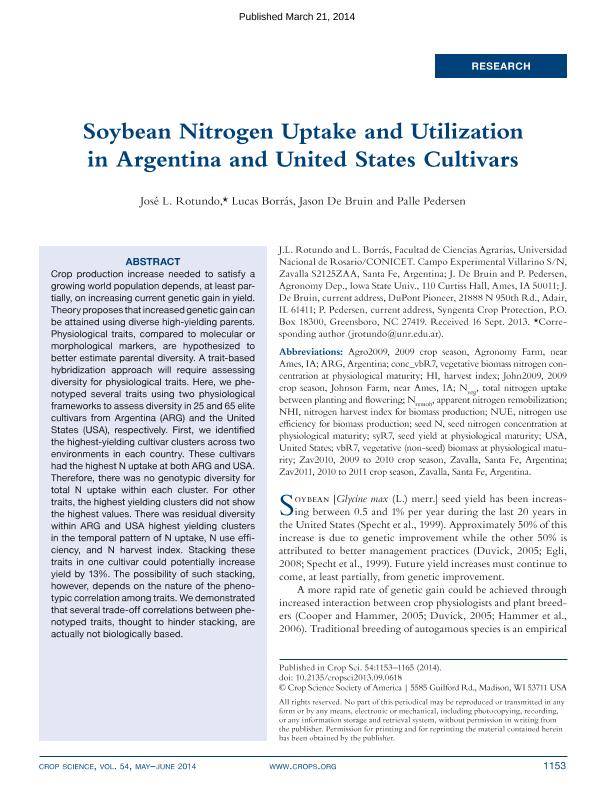Mostrar el registro sencillo del ítem
dc.contributor.author
Rotundo, José Luis

dc.contributor.author
Borras, Lucas

dc.contributor.author
De Bruin, Jason
dc.contributor.author
Pedersen, Palle
dc.date.available
2017-12-06T19:00:35Z
dc.date.issued
2014-03
dc.identifier.citation
Rotundo, José Luis; Borras, Lucas; De Bruin, Jason; Pedersen, Palle; Soybean Nitrogen Uptake and Utilization in Argentina and United States Cultivars; Crop Science Society of America; Crop Science; 54; 3; 3-2014; 1153-1165
dc.identifier.issn
0011-183X
dc.identifier.uri
http://hdl.handle.net/11336/29871
dc.description.abstract
Crop production increase needed to satisfy a growing world population depends, at least partially, on increasing current genetic gain in yield. Theory proposes that increased genetic gain can be attained using diverse high-yielding parents. Physiological traits, compared to molecular or morphological markers, are hypothesized to better estimate parental diversity. A trait-based hybridization approach will require assessing diversity for physiological traits. Here, we phenotyped several traits using two physiological frameworks to assess diversity in 25 and 65 elite cultivars from Argentina (ARG) and the United States (USA), respectively. First, we identified the highest-yielding cultivar clusters across two environments in each country. These cultivars had the highest N uptake at both ARG and USA. Therefore, there was no genotypic diversity for total N uptake within each cluster. For other traits, the highest yielding clusters did not show the highest values. There was residual diversity within ARG and USA highest yielding clusters in the temporal pattern of N uptake, N use efficiency, and N harvest index. Stacking these traits in one cultivar could potentially increase yield by 13%. The possibility of such stacking, however, depends on the nature of the phenotypic correlation among traits. We demonstrated that several trade-off correlations between phenotyped traits, thought to hinder stacking, are actually not biologically based
dc.format
application/pdf
dc.language.iso
eng
dc.publisher
Crop Science Society of America

dc.rights
info:eu-repo/semantics/openAccess
dc.rights.uri
https://creativecommons.org/licenses/by-nc-sa/2.5/ar/
dc.subject
Nitrogen
dc.subject
Soybean
dc.subject
Trait Based Hybridization
dc.subject
Trade-Off Correlations
dc.subject.classification
Agricultura

dc.subject.classification
Agricultura, Silvicultura y Pesca

dc.subject.classification
CIENCIAS AGRÍCOLAS

dc.title
Soybean Nitrogen Uptake and Utilization in Argentina and United States Cultivars
dc.type
info:eu-repo/semantics/article
dc.type
info:ar-repo/semantics/artículo
dc.type
info:eu-repo/semantics/publishedVersion
dc.date.updated
2017-12-06T17:02:56Z
dc.journal.volume
54
dc.journal.number
3
dc.journal.pagination
1153-1165
dc.journal.pais
Estados Unidos

dc.journal.ciudad
Baltimore
dc.description.fil
Fil: Rotundo, José Luis. Universidad Nacional de Rosario. Facultad de Ciencias Agrarias; Argentina. Consejo Nacional de Investigaciones Científicas y Técnicas; Argentina
dc.description.fil
Fil: Borras, Lucas. Universidad Nacional de Rosario. Facultad de Ciencias Agrarias; Argentina. Consejo Nacional de Investigaciones Científicas y Técnicas; Argentina
dc.description.fil
Fil: De Bruin, Jason. University of Iowa; Estados Unidos
dc.description.fil
Fil: Pedersen, Palle. University of Iowa; Estados Unidos
dc.journal.title
Crop Science

dc.relation.alternativeid
info:eu-repo/semantics/altIdentifier/doi/http://dx.doi.org/10.2135/cropsci2013.09.0618
dc.relation.alternativeid
info:eu-repo/semantics/altIdentifier/url/https://dl.sciencesocieties.org/publications/cs/abstracts/54/3/1153
Archivos asociados
